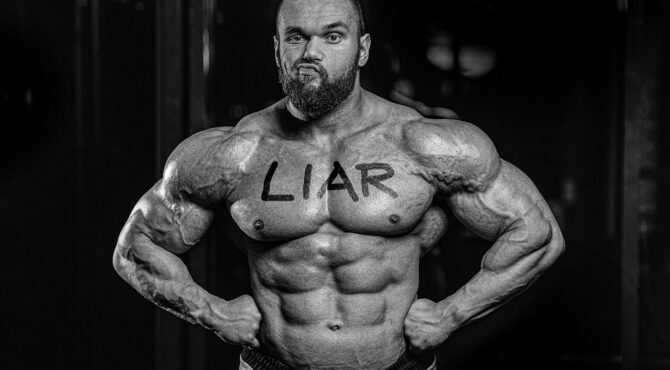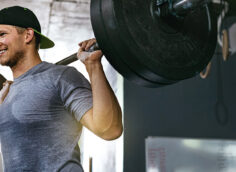Bodybuilding: Beyond Beginner Gains
As a beginner, you probably gained muscle fairly quickly. After all, you went from not lifting to lifting. Almost anything worked back then. After the newbie phase, you had to get smarter. This is where bodybuilding (general term) gets a little more complicated.
You may even have to "un-think" some of the things that seemed to work at first. So what is it that cripples most lifters' progress? Here are six common lies about building your body.
Only powerlifters have to squat with a barbell on their backs. Performed properly, the squat is an outstanding bodybuilding exercise – one of the very best. But the emphasis is on "properly done."
No matter what they do, many lifters will never be good barbell squatters because of their non-squat-friendly physical configuration or back or knee problems.
A minority of bodybuilders are highly suited to barbell squats. Another minority of bodybuilders are highly unsuited to barbell squats (including very lanky lifters). But the majority are somewhere in between.
Many of those "in-between" lifters can become decent (but not exceptional) barbell squatters with excellent coaching. But such coaching is hard to come by.
Even those with excellent physical configuration for squatting and healthy knees and backs never take advantage of the barbell squat's huge potential. Why? Because they never learn excellent squatting form.
If you can barbell squat well (which includes being able to keep a flat back at just below parallel while wearing no more than a three-quarters-inch heel) and maintain excellent form even when squatting intensively, squat on.
If not, try the safety bar squat, the trap bar deadlift shown below, with generous flexion of your knees (using the low handles if you can do so safely), a good squat machine, or the belt squat machine. If none of those works well for you, try a leg press machine.
Even bodybuilders can benefit greatly from this powerlifting staple. Done properly, the deadlift is one of the very best exercises for building strength and muscle mass. And it's often an exercise well-suited to those who aren't well-suited to the barbell squat and bench press.
Interestingly, bodybuilders who are physically well-configured for the barbell squat and bench press often struggle with the conventional deadlift.
The only problem? If you have terrible form, you're going to think it's dangerous, just like the squat. That's why those two exercises often get bad press. So make sure you use the correct form or don't do the exercise at all.
If you can't do the conventional deadlift safely, do the simpler Romanian deadlift, which involves only a little knee flexion but plenty of hinging to target your posterior chain.
To simplify setting up for the Romanian deadlift, do it in a power rack with the barbell on pins two inches below your knee caps. Even if you can do the conventional deadlift safely, you may still prefer the partial Romanian deadlift.
The barbell bench press can build strength and muscle mass. But if you've stalled out and your technique doesn't need improvement, why persist with that exercise? Other lifts will be more productive and satisfying for you.
Try the parallel bar dip (conventional style or on a good machine) and the supine, low-decline, and low-incline presses on good machines to find the best one or two for you.
But you must set up the machines to suit you and use immaculate form. With the dip, go no lower than where your triceps are parallel to the floor, keep your reps smooth, and maintain a full chest of air during each descent and ascent.
Flat and low-incline dumbbell presses can be excellent alternatives to the barbell bench press. With dumbbells, you can find the hand and elbow positions that give you your best pressing groove.
You just need to master getting the dumbbells into and out of position for each set, find your best pressing groove, and avoid excessive depth.
A bodybuilding workout will build muscle only if it stimulates growth and is followed by enough recovery time, sleep, and a sufficient supply of nutrients that permit the body to heal.
Train too often and you may not stimulate any growth because you're unable to train hard enough. And even if you stimulate growth, you won't have sufficient recuperation time between workouts to realize the full benefits.
If you're young and have a leisurely lifestyle and good genetics for bodybuilding, you may initially make some modest progress from four or more workouts a week. But why not optimize your recovery ability, make more progress, and, as a bonus, spend less time in the gym?
It's easy for a natural bodybuilder with normal genetics to overtrain. But someone with outstanding genetics for bodybuilding can prosper on more frequent training, and such a person can prosper on even more frequent training if he's on bodybuilding drugs.
Typical lifters are best off training no more than three times a week; just twice a week is better for most. Never mind that many drug-assisted super-responsive bodybuilding champions prospered on six workouts a week. Some of them, for short periods, even prospered on twice-daily training, six days a week.
Such a high frequency is training suicide for typical bodybuilders. Most split routines are problematic for average lifters. The physiological system is so interwoven, and many exercises overlap in the muscles and other tissues they recruit.
Furthermore, hard training for just a limited area of the body still produces a systemic demand that you need to be recover from. If you train too often, you'll never recover from systemic fatigue and will make little or no bodybuilding progress. Have more recovery days than training days!
Make three work sets per exercise your ceiling. Sometimes, it's even better to do just one or two work sets per exercise.
The recommendations for high volume commonly come from drug users, including those who claim to be "natural." Some of the most amazing, legitimately drug-free bodybuilders also recommend high-volume training. But they have freaky genetics for it and thus a tremendous advantage over typical drug-free bodybuilders.
Much of the information to support high-volume training is based on the results of misunderstood and/or misrepresented studies or pseudoscience.
Too much training is as counterproductive as training too often. But most typical bodybuilders train too often and do too many sets per workout. Of course, volume plays an important role in the muscle-building process, but intensity comes first. You won't stimulate any growth if you don't train hard enough, no matter how much volume you do.
Low-volume training is highly effective, provided you use a selection of the best exercises for you, apply excellent form, train hard, don't train too frequently, eat well, sleep generously, and strive to make progress. But most struggling bodybuilders fail on all those fronts.
The pros have great advice for other bodybuilders with stellar genetics and drug assistance. But for genetically normal, drug-free lifters, a different approach is needed. No champion bodybuilder can get in the shoes of a genetically typical natural lifter.
Someone who struggled for years without building much muscle – but then learned how to train effectively and built 25 pounds of muscle drug-free – knows more about training genetically normal, drug-free bodybuilders than a genetic stud on drugs who's built 100 pounds of muscle.




